
Cassino is a comune in the province of Frosinone, Southern Italy, at the southern end of the region of Lazio, the last city of the Latin Valley.

The Liri is one of the principal rivers of central Italy, flowing into the Tyrrhenian Sea a little below Minturno under the name Garigliano.

Albano Laziale is a comune in the Metropolitan City of Rome, on the Alban Hills, in Latium, central Italy. Rome is 25 kilometres (16 mi) distant. It is bounded by other communes of Castel Gandolfo, Rocca di Papa, Ariccia and Ardea. Located in the Castelli Romani area of Lazio. It is sometimes known simply as Albano.
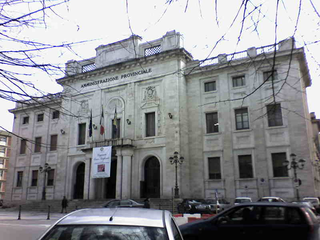
The Province of Frosinone is a province in the Lazio region of Italy, with 91 comuni. Its capital is the city of Frosinone. It has an area of 3,247 square kilometres (1,254 sq mi) and a total population of 493,605 (2016).
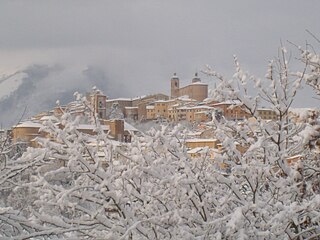
Camerino is a town in the province of Macerata, Marche, central-eastern Italy. It is located in the Apennines bordering Umbria, between the valleys of the rivers Potenza and Chienti, about 64 kilometres (40 mi) from Ancona.

Arce is a comune (municipality) in the province of Frosinone, in the region of Lazio, Italy. it is an agricultural centre located on a hill overlooking the Via Casilina, in the Latin Valley and in the middle valley of the Liri.
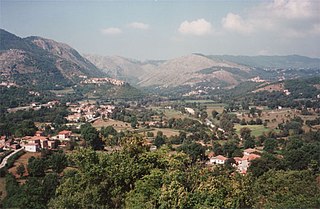
The Valle di Comino is a valley in the province of Frosinone, in Lazio in central Italy. It runs from San Biagio Saracinisco to Vicalvi and is adjacent to the Abruzzi mountains. It grossly corresponds to the upper valley of the Melfa river, which runs through it before joining the Liri.
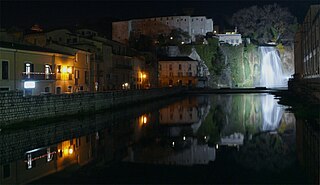
Isola del Liri is an Italian town of Lazio, Italy, in the province of Frosinone. As its name implies, Isola is situated between two arms of the Liri. The many waterfalls of this river and of the Fibreno are used by factories.

The Duchy of Sora was a semi-independent state in Italy, created in 1443 by King Alfonso I of Naples and dissolved in 1796. It occupied the south-eastern part of what is today Lazio, bordering what is now Abruzzo. Its capital was first Sora, and later, under the Boncompagni family, Isola di Sora.
Terra di Lavoro is the name of a historical region of Southern Italy. It corresponds roughly to the modern southern Lazio and northern Campania and upper north west and west border area of Molise regions of Italy.

Rocca di Papa is a small town and comune in the Metropolitan City of Rome, Lazio, Italy. It is one of the Castelli Romani about 25 kilometres (16 mi) southeast of Rome on the Alban Hills. It is close to the other communes of Velletri, Rocca Priora, Monte Compatri, Grottaferrata, Albano and Marino. It is the center of the Regional Park known as the "Parco Regionale dei Castelli Romani".
Belcastro is a comune in the province of Catanzaro, in the Calabria region of southern Italy.

Arcevia is a comune in the province of Ancona of the region of Marche, central-eastern Italy.

Strangolagalli is a comune (municipality) in the province of Frosinone in the Italian region Lazio, located about 90 kilometres (56 mi) southeast of Rome and about 12 kilometres (7 mi) southeast of Frosinone. It is located on the slopes of Ernici Mountains, towards the Liri River. Economy is based mainly on agriculture, numerous inhabitants commuting to nearby industries for work.

Valle Latina is an Italian geographical and historical region that extends from the south of Rome to Cassino, corresponding to the eastern area of ancient Roman Latium.
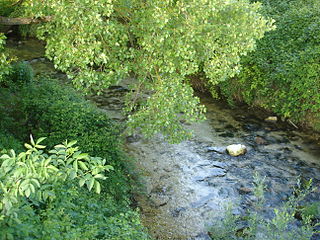
The Melfa is a river in Lazio, Italy. It rises in the Monti della Meta, flows south-west for about 40 kilometres (25 mi) and joins the Liri near San Giovanni Incarico.

Aquino is a town and comune in the province of Frosinone, in the Lazio region of Italy, 12 kilometres (7 mi) northwest of Cassino.

Pontecorvo is a town and comune in the province of Frosinone, Lazio, Italy. Its population is c. 13,200.
Atenulf was the Abbot of Montecassino from 1011 until his death. He was a cousin of Prince Pandulf II of Capua, a younger son of Prince Pandulf III and brother of Prince Pandulf IV.
Isoletta is a village in Italy, in the Valle Latina within the Arce municipality. Isoletta is located in the province of Frosinone, of the southern Lazio region in Italy.


















